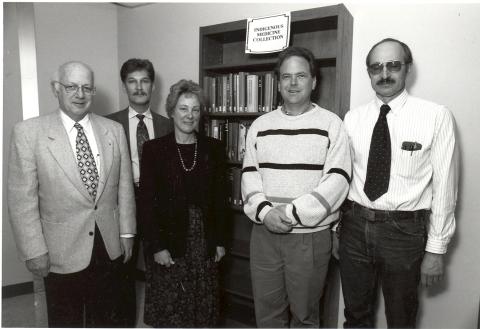1975 - Henry Strauss, a trained pharmacist, makes his first trip to China to discuss a potential partnership with the China National Native & Animal By-Product Import & Export Corporation around the distribution a cold-relief tablet. During his brief visit, representatives from the corporation tour Henry through a commune, hospital, pharmacy, and acupuncture anesthesia operation where he was able to observe traditional Chinese treatments in practice. Seeing the efficacy of the practices, Henry develops an interest in Indigenous healing methods
Mid - Late 1970's - Henry is appointed sole distributor of the Bi Yan Piam Cold Tablet for the United States and works with the University of Colorado Patent Office to contact more than 120 drug companies to set up distribution partnerships. In the process, Henry visits China several more times, and knowing there are limited resources in the United States on Chinese Indigenous practices, begins acquiring books on the topic. Henry abandons his distribution efforts of the cold-relief tablet after three years.
Mid - 1980's - Henry arranges a sabbatical for John Singleton, then Dean of Faculty Affairs at the University of Colorado’s Medical School, to study Chinese medicine in the Hunan Providence of China. Before John departs, Henry lends him the collection of Chinese medicine books he had acquired on his visits to the country.
Early 1990's - Upon John’s return, and with the support of his wife, Henry asks Rick Forsman, Library Director, if the Denison Memorial Library at the University of Colorado Health Sciences Center would be interested in housing his collection of Chinese medicine books. After some consideration, Forsman agrees and asks Henry to work with librarian Pat Nelson

1995 - In memory of his first wife, Strauss establishes the Florence G. Strauss Indigenous Medicine Collection Endowment Fund at the Health Sciences Library. The focus of the collection expands from Chinese medicine to all forms of complementary health practices and Indigenous therapies from around the world.
In the same year, a governing committee is created to oversee the selection and acquisition of new materials for the collection. The original Strauss Committee consists of members from the university’s library and medical communities: Henry Strauss, Pat Nelson, John Singleton, Henry Clayman, Sylvan Stool, Andrea Cohen, Martha Libster and Joan Brett.
1996 - 2009 - Henry remains a constant supporter of the collection, donating books related to Indigenous medicine that he has purchased during numerous international trips.
2010 - Henry meets Leonard Wisneski, MD and quickly realizes they share a passion and interest in Indigenous medicine. After learning Len has a large personal library on the subject matter, Henry convinces Len to donate many of the books to the library. Upon their receipt, the collection is renamed the Florence G. Strauss-Leonard A. Wisneski Indigenous and Integrative Medicine Collection. Due to evolving language, the term “traditional” is also dropped from the collection name and the term “integrative medicine” is added.
2021 - Henry Strauss passes away on April 8 at the age of 93. With his passing, he donates additional funds to the endowment which funds a faculty librarian position and ensures continued support for collection.
2022 - In light of evolving terminology and in recognition of the collaborative nature of integrative health, including the variety of professionals in the field, the Strauss Committee votes to update the name of the collection from “integrative medicine” to “integrative health”. The collection is now known as the Florence G. Strauss-Leonard A. Wisneski Indigenous and Integrative Health Collection.
2023 - The Strauss Library hires Special Collections Librarian, Lori Micho, to oversee the development of the Florence G. Strauss-Leonard A. Wisneski Indigenous and Integrative Health Collection and manage programming related to Indigenous and integrative health.
